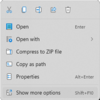1) Please reinstall:
spvdport SoftPerfect Virtual Disk c:\windows\system32\drivers\spvdbus.sys
Name SoftPerfect Virtual Bus
Manufacturer KEG
Status OK
PNP Device ID ROOT\SCSIADAPTER\0000
Driver C:\WINDOWS\SYSTEM32\DRIVERS\SPVDBUS.SYS (, 97,43 KB (99 768 bytes), 2022-07-06 09:36)
2) Make a new retore point
3)Restart WDV with all customized tests except:
[ ] 0x00000004 Randomized low resources simulation.
Post a new querysettings and / or V2 into the newest post.
spvdport SoftPerfect Virtual Disk c:\windows\system32\drivers\spvdbus.sys
Name SoftPerfect Virtual Bus
Manufacturer KEG
Status OK
PNP Device ID ROOT\SCSIADAPTER\0000
Driver C:\WINDOWS\SYSTEM32\DRIVERS\SPVDBUS.SYS (, 97,43 KB (99 768 bytes), 2022-07-06 09:36)
2) Make a new retore point
3)Restart WDV with all customized tests except:
[ ] 0x00000004 Randomized low resources simulation.
Post a new querysettings and / or V2 into the newest post.
My Computer
System One
-
- OS
- Windows 10
- Computer type
- Laptop
- Manufacturer/Model
- HP
- CPU
- Intel(R) Core(TM) i7-4800MQ CPU @ 2.70GHz
- Motherboard
- Product : 190A Version : KBC Version 94.56
- Memory
- 16 GB Total: Manufacturer : Samsung MemoryType : DDR3 FormFactor : SODIMM Capacity : 8GB Speed : 1600
- Graphics Card(s)
- NVIDIA Quadro K3100M; Intel(R) HD Graphics 4600
- Sound Card
- IDT High Definition Audio CODEC; PNP Device ID HDAUDIO\FUNC_01&VEN_111D&DEV_76E0
- Hard Drives
- Model Hitachi HTS727575A9E364
- Antivirus
- Microsoft Defender
- Other Info
- Mobile Workstation


















